Stovetop Beef Stew Recipe (Gluten Free)
As the air turns crisp and the days grow shorter, nothing warms the soul quite like a hearty pot of beef stew simmering on the stove. This stovetop beef stew is a classic comfort meal, made gluten-free and with fewer steps than most recipes; no messy flour dredging required. With tender chunks of chuck roast, rich tomato paste, fresh herbs, and vegetables that soften into the broth, this stew is a cozy one-pot meal or meal prep recipe you’ll want to revisit all season long.
Why You’ll Love this Recipe
- Gluten free without losing any flavor or complexity
- Coziness any time of year
- Easy way to understand how cooking techniques can impact the final recipe
What You’ll Walk Away Knowing
- What a mirepoix is
- How to deglaze the pot to increase flavor
- How to avoid tough meat
Stovetop Beef Stew Techniques
Making beef stew is really about technique. By doing a few things right, you can guarantee a tender and cozy bowl of stew. This isn’t a dump and go recipe, but the results are so worth the time to learn what goes into making a bowl of stew that delights.
Cutting the Chuck Roast Against the Grain
How you slice your chuck roast matters. By cutting against the grain, you create tender, melt in your mouth meat. You cut against the grain by looking at the lines in the meat fiber. They should be going one way. You want to angle your knife so that it’s crossing the lines in the meat fiber instead of going the same way.
Searing
Searing the meat is not meant to cook it fully. All we’re looking for is a brown sear. The meat will cook the rest of the way by simmering. We want to briefly sear the stew meat and then work on our mirepoix.
Mirepoix
Mirepoix is the flavor base of many dishes. In this case, it is the onions, carrots, and celery. If you just toss them into the chicken stock, they won’t gain any additional flavor. By sauteing them in the beef fat and seasonings, we are caramelizing the vegetables. The natural sugars in the vegetables are cooked and add a complexity that just throwing them in the broth won’t do.
Umami
That is the same reason we add the dried herbs, Worcestershire, and tomato paste before adding the stock. By blooming the dried herbs in oil, the flavors are opened up. The tomato paste gets a chance to coat the vegetables and meat to caramelize a bit more. Lots of flavorful brown bits will stick to the bottom of the pot, we want this to happen to build more flavor.
Deglazing
At this point, we deglaze the pot with the chicken stock. Deglazing is the process of adding a liquid to the pot to loosen the brown bits on the bottom of the pot. You can deglaze with wine if you prefer before adding the stock, but I never do.
Simmering
At this point, we need to bring the pot to a simmer. Simmering is when we have gentle bubbles rising from the broth. We never want a rolling boil or anything close to it because that will eviscerate the vegetables and toughen the meat.
By simply taking the time to understand these techniques and implementing them, you can turn a blah bowl of soup, into a cozy winter staple that your family asks for again and again.
Ingredient List
Chuck Roast: I like to get a chuck roast that’s 2.5-3 pounds. You can really do as much meat as you like. I don’t cut any of the fat or connective tissue off of my roast. The stewing process softens the meat, fat, and tissue so that it completely melts in your mouth. If you prefer, you can trim the fat and anything on the roast that you want.
Potatoes: I prefer russet potatoes because I like their starch content and I always have them on hand. You can also use yukon gold or red potatoes. These are waxy potatoes so they won’t lend any starch to the broth which is fine, but they’re a firmer texture than russet potatoes.
Oil: I like to use avocado oil to saute the meat and vegetables. You can also use butter if you prefer.
Chicken Stock: I make my own salt free chicken stock at home. It allows me to save money and use the vegetable scraps I already have from everyday cooking. If you want more information about making your own stock at home, here is my post about making chicken stock in an Instant Pot. If you do buy it from the store, either buy salt free or reduce the amount of salt you use in the recipe because this recipe is made without salt in the stock.
Tomato Paste: If you’ve made any of my other recipes, you’ll see that I don’t like to have random ingredients in my refrigerator after making a meal. This recipe uses a whole 6 oz can of tomato paste.
Cornstarch: This is what turns this recipe from a soup consistency to a stew consistency. If you don’t want to use cornstarch, you can substitute 1 for 1 with arrowroot.
Step-by-Step Instructions
Cook the Meat
- Heat a heavy-bottom pot to medium heat. Add 2 tablespoons of avocado oil and let heat up. While that’s heating, mix 1 tablespoon each of salt, pepper, and paprika together,
- Add about ⅓ of the chuck roast chunks and sprinkle with 1 tablespoon of the spice mixture. Cook on one side for three minutes. Then flip and do the other side. Remove the meat and set aside. Cook the rest of the meat in ⅓ batches the same way.
Saute the Vegetables
- Add 2 more tablespoons of avocado oil. Saute the onion, carrots, and celery for 8 minutes with 1 tablespoon of garlic powder, onion powder, and salt and 1 teaspoon of cayenne. Stirring often until the vegetables start to soften.
- Add all of the chuck roast back to the pan and stir. Add rosemary, thyme, fresh garlic, and 2 tablespoons Worcestershire and stir. Let garlic cook for 30 seconds
- Add tomato paste and stir. Let it cook for 1-2 minutes to caramelize it a bit
- Add potatoes and enough chicken stock to cover everything, about 6 cups. Bring the stew to a simmer. Add bay leaves and let simmer uncovered for 1 hour.
- Check the tenderness of the meat and taste for seasoning. After an hour, the beef should be fork-tender. We’ll still be cooking the stew for about 30 more minutes so if it’s not tender, don’t worry. Feel free to add salt or other seasonings. If the broth is too salty for your taste you can add a cup of water, stir, and taste again.
- Add the peas and simmer for another 20 minutes.
- When the peas are tender, mix cornstarch with equal parts water to create a slurry. Slowly stir the cornstarch mixture into the stew and stir thoroughly to disperse it. Allow the stew to cook for 10 more minutes to thicken. If it isn’t thickened to your taste, you can add another tablespoon of cornstarch mixed with a tablespoon of water. Let it simmer and see if it’s thick enough.
Expert Tips
The purpose of searing the meat is to get a nice brown color on the meat and begin to soften the connective tissue. If you just throw the meat in the stew, it could turn an unappetizing gray color.
I have never found a purpose for tossing the chuck roast in flour before searing. Mine has always seared beautifully without flour and it’s one less step to make the recipe. The thickening of the broth comes mostly from the cornstarch. So if you’re gluten free this is the perfect recipe for you.
This recipe is perfect for potlucks or make ahead meals. It tastes even better the next day and travels well.
I don’t peel any of my vegetables. I like the rustic look and texture that the skins provide. You can feel free to do whatever you prefer.
What to Serve with Beef Stew
My favorite appetizer to serve with beef stew is Garlic and Herb Olive Oil Bread Dip. You can use your crusty bread to dip into your stew or the herb dip. It turns dinner from classic to elevated and cozy. If you just want a crusty chunk of bread, these ciabattas are a perfect accompaniment. Cornbread is another close favorite.
Storage
You can store this stew in the refrigerator for up to 5 days. It gets better with time for the flavors to marry.
This Stove Top Beef Stew is perfect to make a large batch and freeze. I like to either put mine in a large container if we plan to have stew for dinner again or in smaller containers if I want to eat it for lunch.
FAQs
Yes, you can. The flour used to coat the beef isn’t enough to lend to very much thickening. The cornstarch is what thickens the stock. You can completely omit the flour. If you can’t have cornstarch, you can substitute arrowroot. If you’d prefer to not use any thickener, you can take some of the cooked potatoes out and mashed them before adding them back in. You won’t get a thickness as if you added a thickener, but it will add some viscosity to the stock.
You can use chicken stock, water mixed with bouillon, or plain water if you want to add a lot of extra herbs to compensate. The whole can of tomato paste does a lot of the leg work.
Yes, you can use avocado or another neutral tasting oil in place of butter.
Yes, the beef flavor comes from the chuck roast itself and the umami comes from the tomato paste.
You can, but I feel like it’s a step for convenience that is a detriment to the end product. When you cut your own, you can make sure to cut against the grain for better texture.
With the seasons about to change, I love making homemade stovetop beef stew. Subscribe to my newsletter if you want to follow along with my fall and winter recipes. Leave a comment if you enjoyed this recipe or if you have any suggestions for recipes you’d like to see.
Stovetop Beef Stew
Equipment
- Heavy Bottom Pot
Ingredients
- 2.5- 3 lbs chuck roast cut into 1 inch chunks
- 1 tablespoon salt
- 1 tablespoon black pepper
- 1 tablespoon paprika
- 8 garlic cloves minced
- 2 cups onion about 2
- 2 cups carrots about 4
- 2 cups celery stalks about 4
- 1 tablespoon garlic powder
- 1 tablespoon onion powder
- 1 tablespoon salt
- 1 teaspoon cayenne pepper
- 2 tablespoon Worcestershire
- 6 potatoes diced
- 6 cups chicken stock
- 6 ounce can tomato paste
- 1 tablespoon dried rosemary
- 1 teaspoon dried thyme
- 3 bay leaves
- 1 ½ cups frozen peas 12 ounce bag
- 3 tablespoons cornstarch
- 3 tablespoons water
Instructions
Cook the Meat
- Heat a heavy-bottom pot to medium heat. Add 2 tablespoons of avocado oil and let heat up. While that’s heating, mix 1 tablespoon salt, 1 tablespoon black pepper, and 1 tablespoon paprika together.
- Add about ⅓ of the 2.5- 3 lbs chuck roast and sprinkle with 1 tablespoon of the spice mixture. Cook on one side for three minutes. Then flip and do the other side. Remove the meat and set aside. Cook the rest of the meat in ⅓ batches the same way.
Cook the Vegetables
- Add 2 more tablespoons of avocado oil. Saute 2 cups onion, 2 cups carrots, and 2 cups celery stalks for 8 minutes with 1 tablespoon garlic powder, 1 tablespoon onion powder, and 1 tablespoon salt and 1 teaspoon cayenne pepper. Stirring often until the vegetables start to soften.
- Add all of the chuck roast back to the pan and stir. Add 1 tablespoon dried rosemary, 1 teaspoon dried thyme, 8 garlic cloves, 2 tablespoon Worcestershire and stir. Let garlic cook for 30 seconds
- Add 6 ounce can tomato paste and stir. Let it cook for 1-2 minutes to caramelize it a bit
- Add 6 potatoes and 6 cups chicken stock to cover everything. Bring the stew to a simmer. Add 3 bay leaves and let simmer uncovered for 1 hour.
- Check the tenderness of the meat and taste for seasoning. After an hour, the beef should be fork-tender. We’ll still be cooking the stew for about 30 more minutes so if it’s not tender, don’t worry. Feel free to add salt or other seasonings. If the broth is too salty for your taste you can add a cup of water, stir, and taste again.
- Add 1 ½ cups frozen peas and simmer for another 20 minutes.
- When the peas are tender, mix 3 tablespoons cornstarch with 3 tablespoons water to create a slurry. Slowly stir the cornstarch mixture into the stew and stir thoroughly to disperse it. Allow the stew to cook for 10 more minutes to thicken. If it isn’t thickened to your taste, you can add another tablespoon of cornstarch mixed with a tablespoon of water. Let it simmer and see if it’s thick enough.
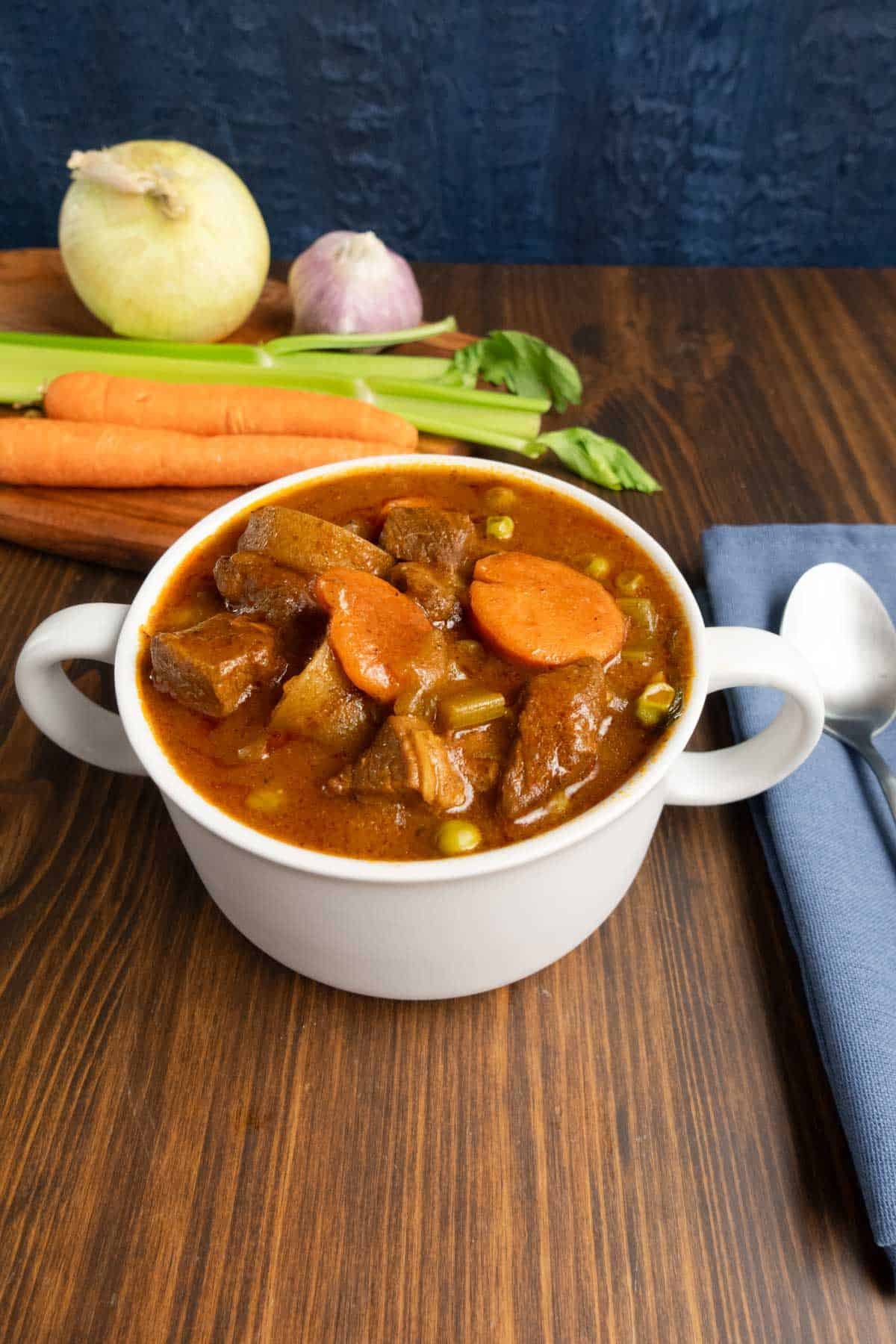
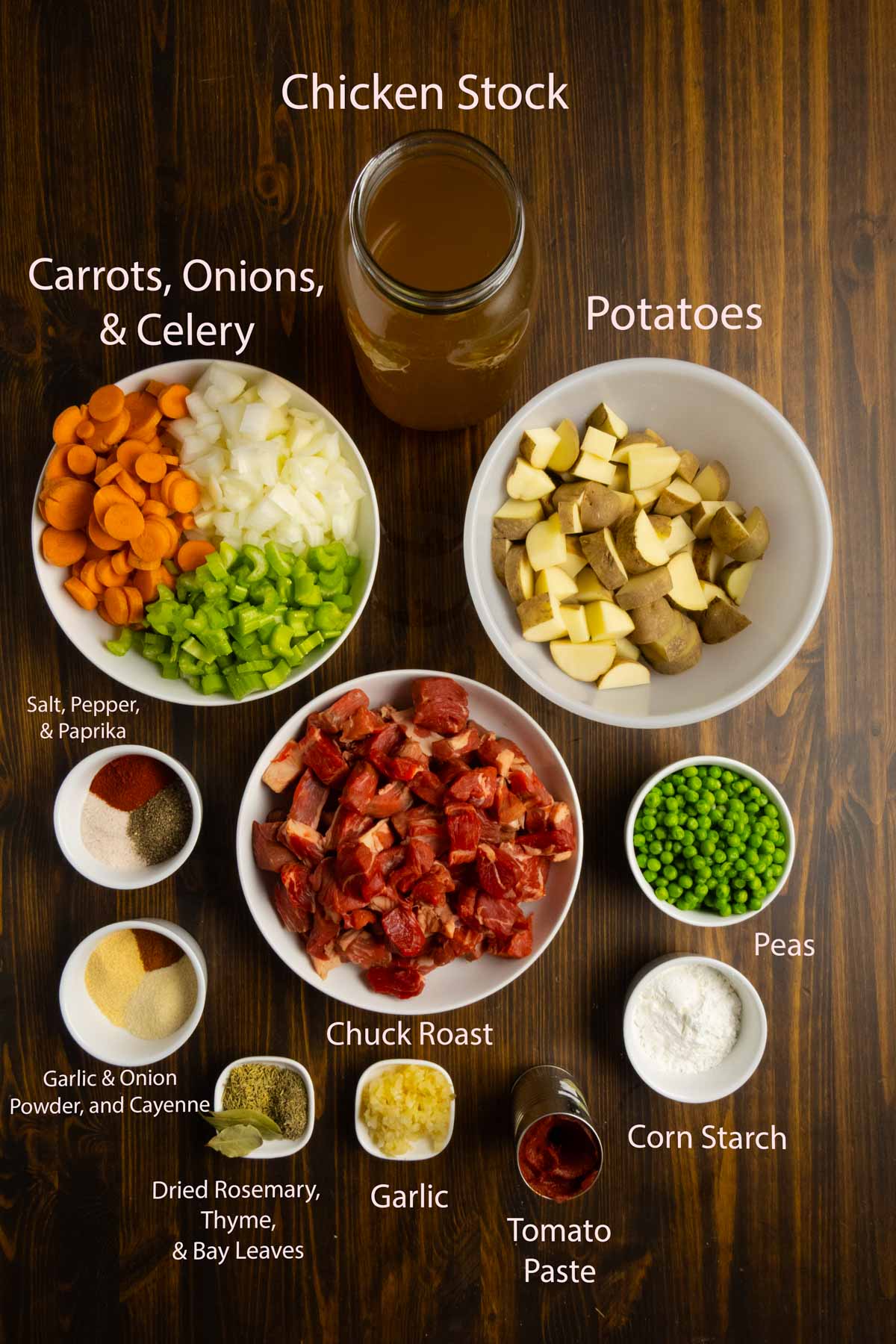
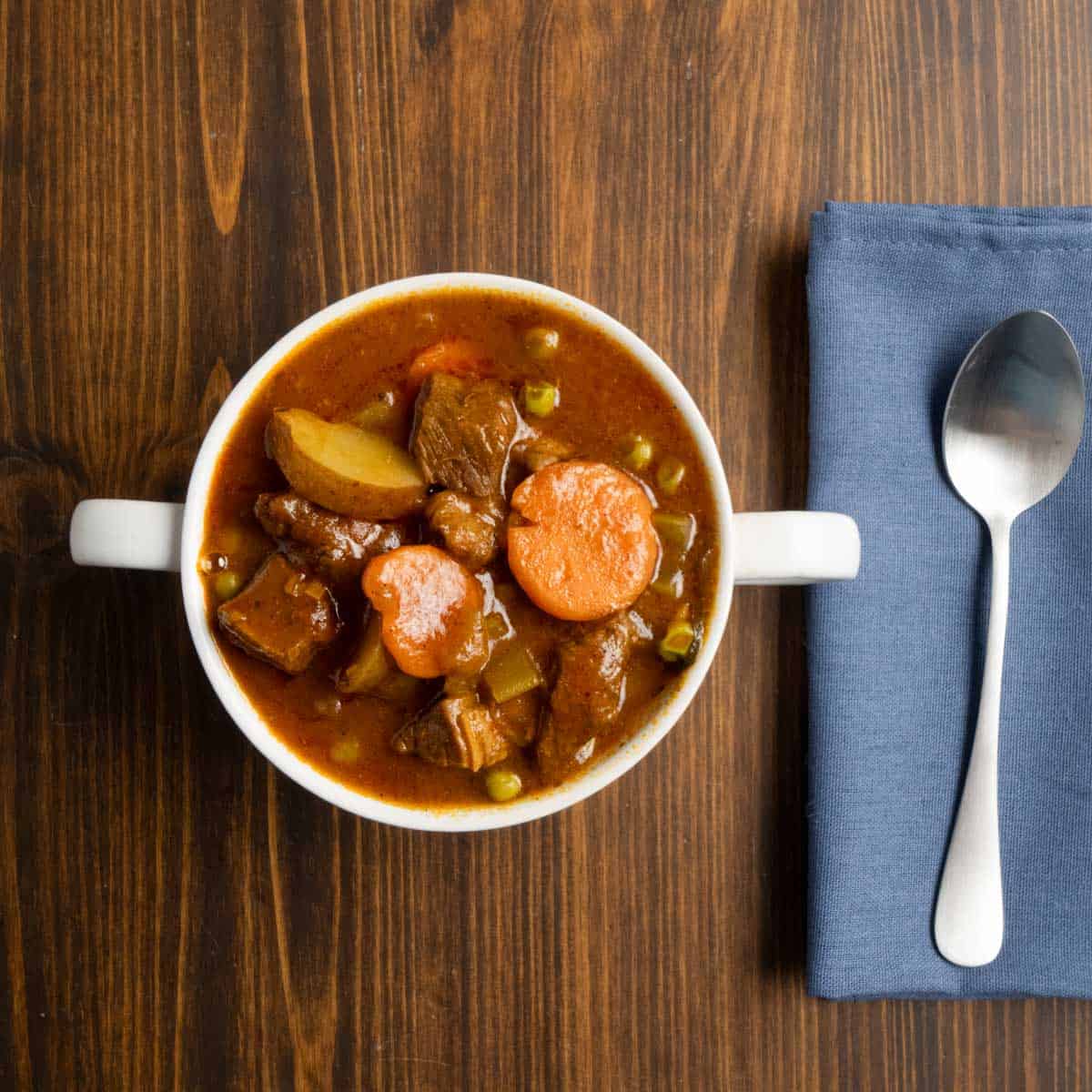
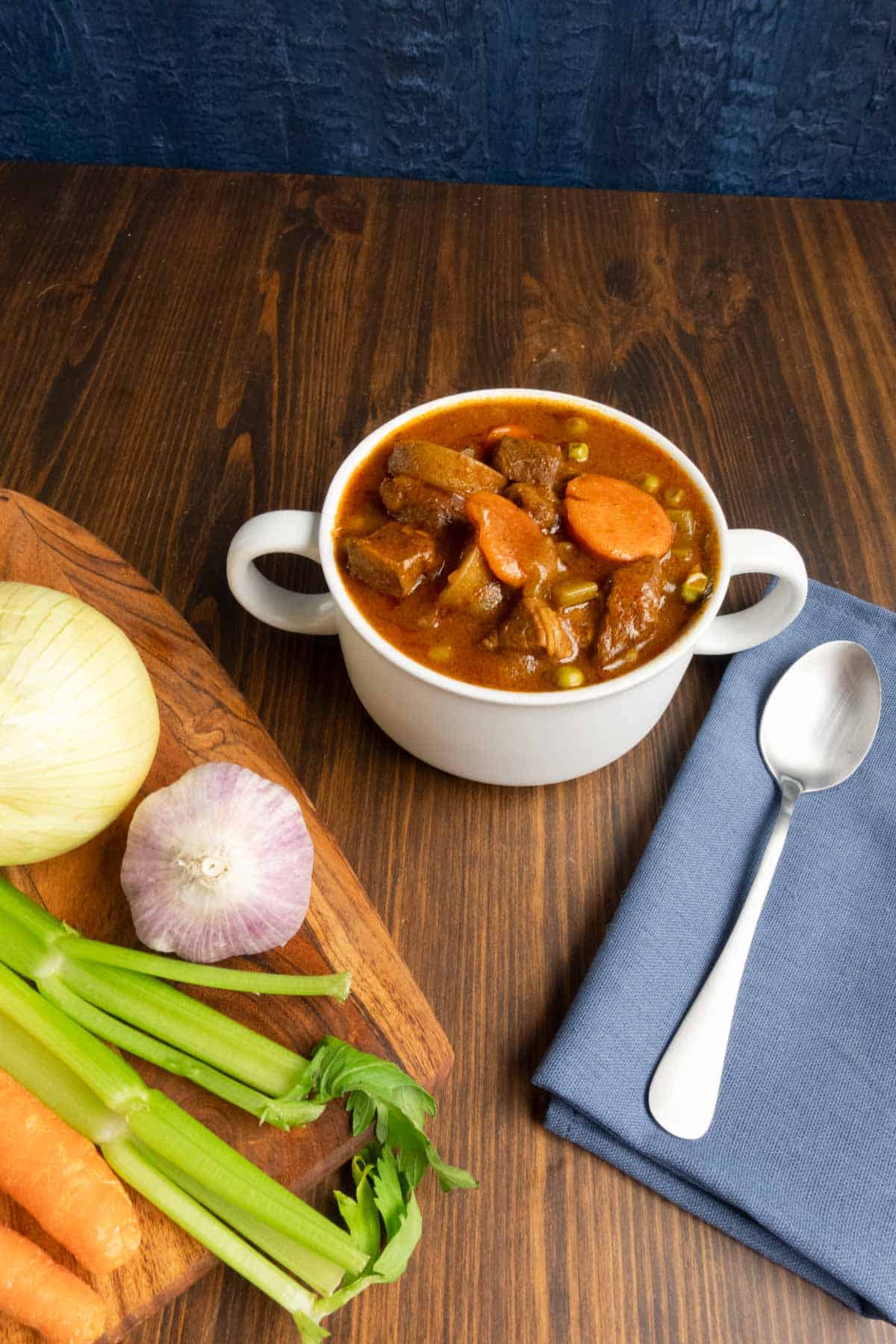
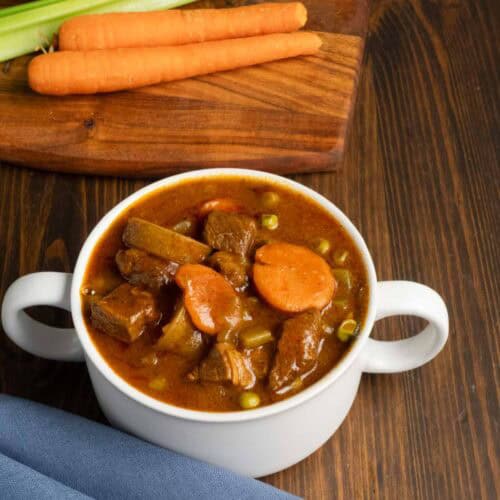
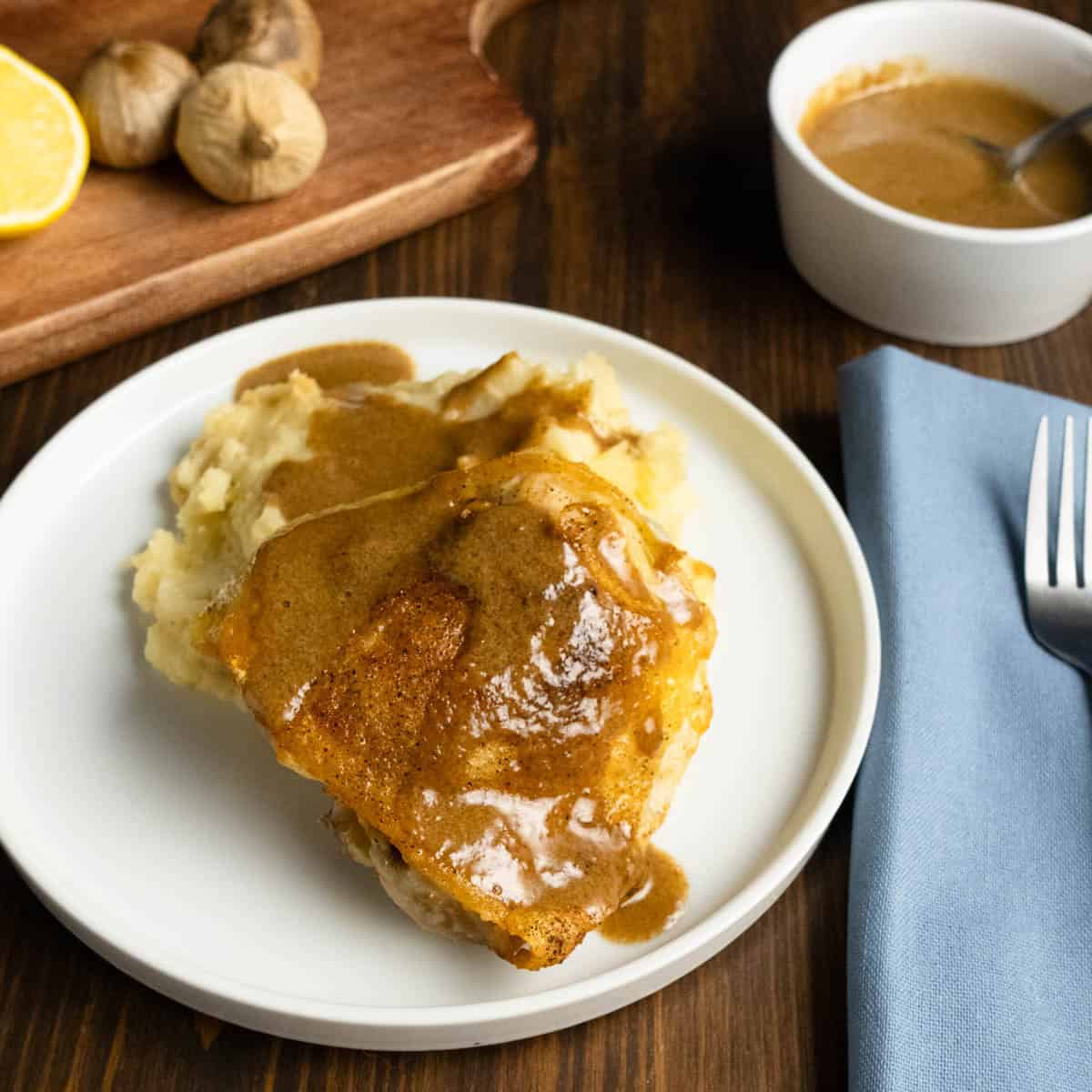
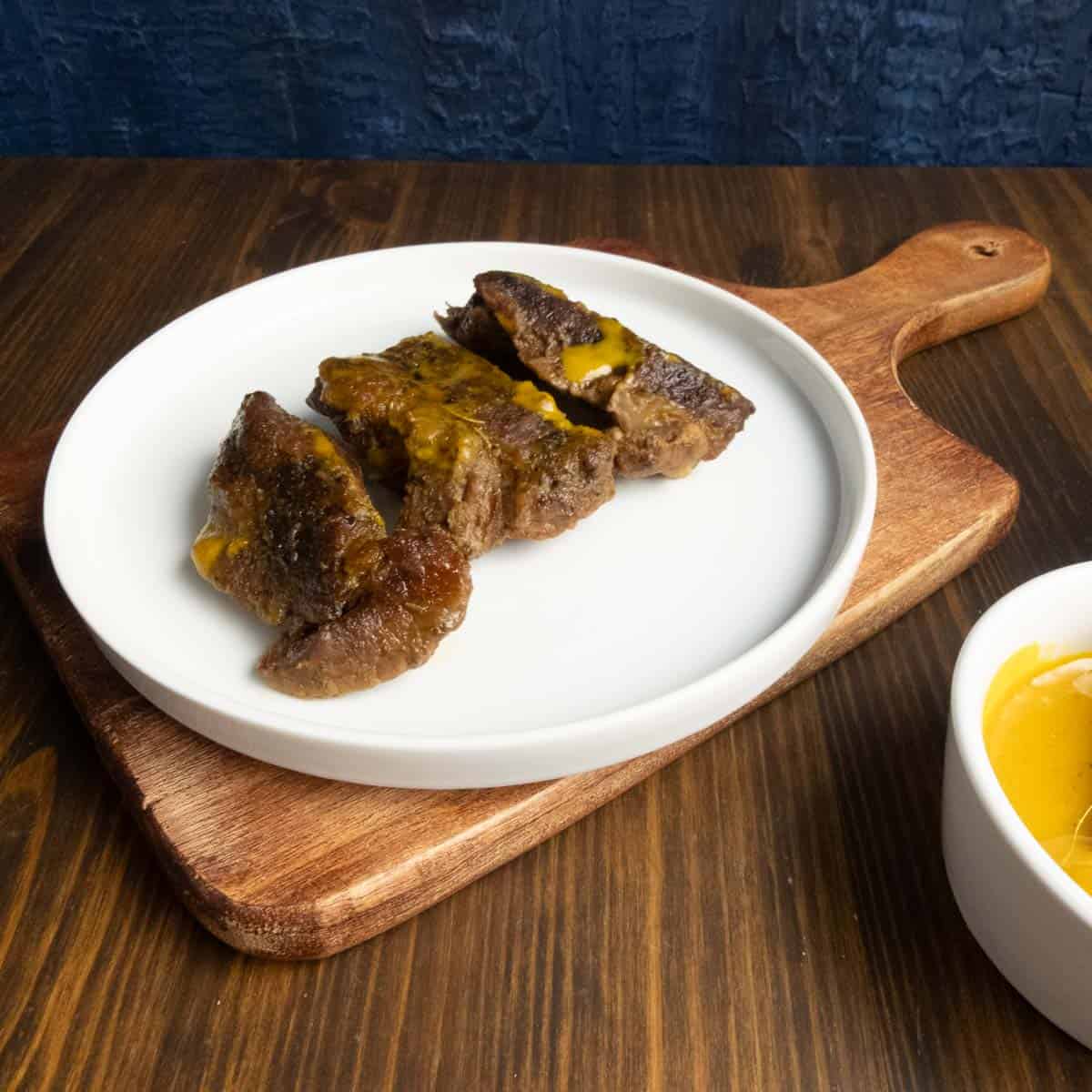
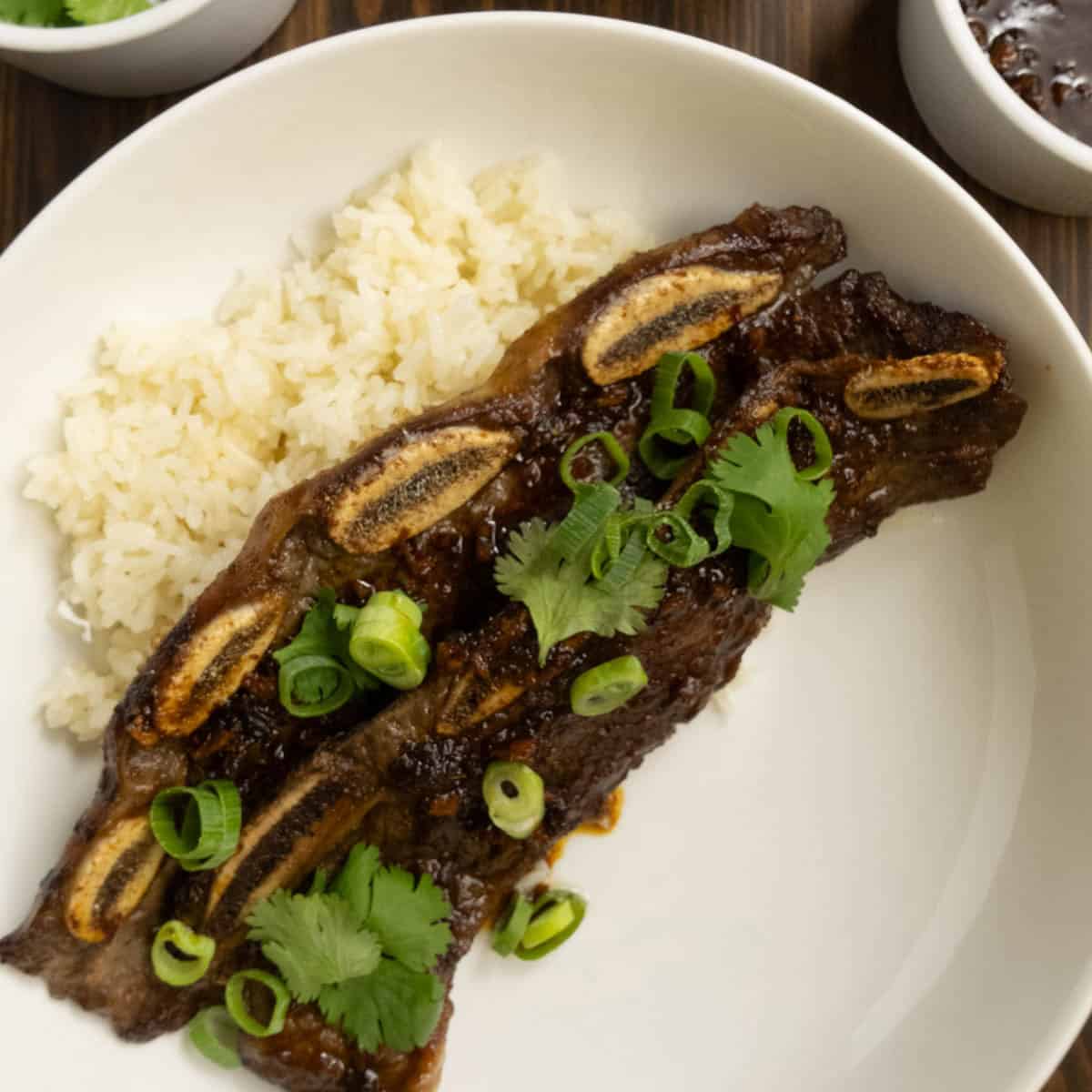

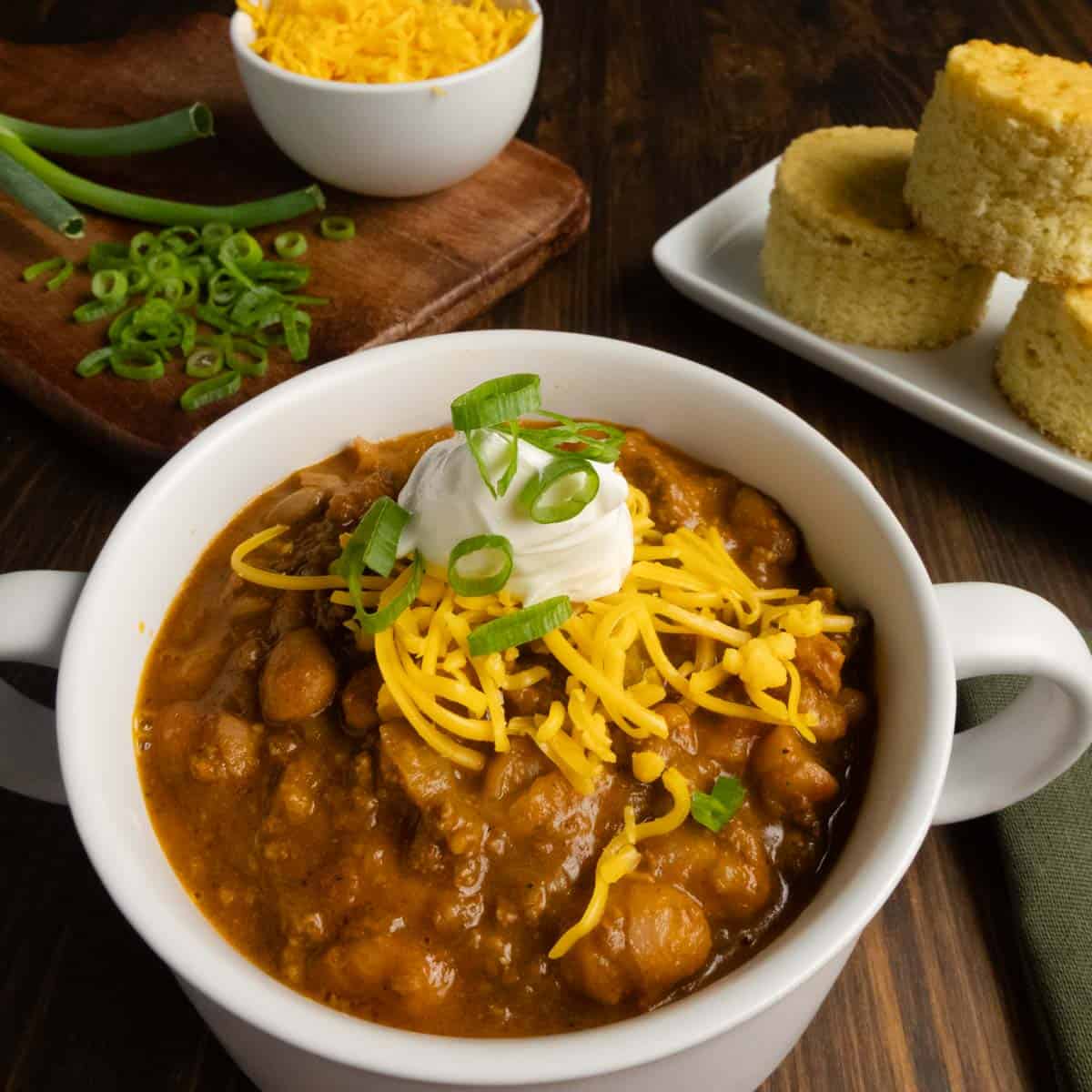
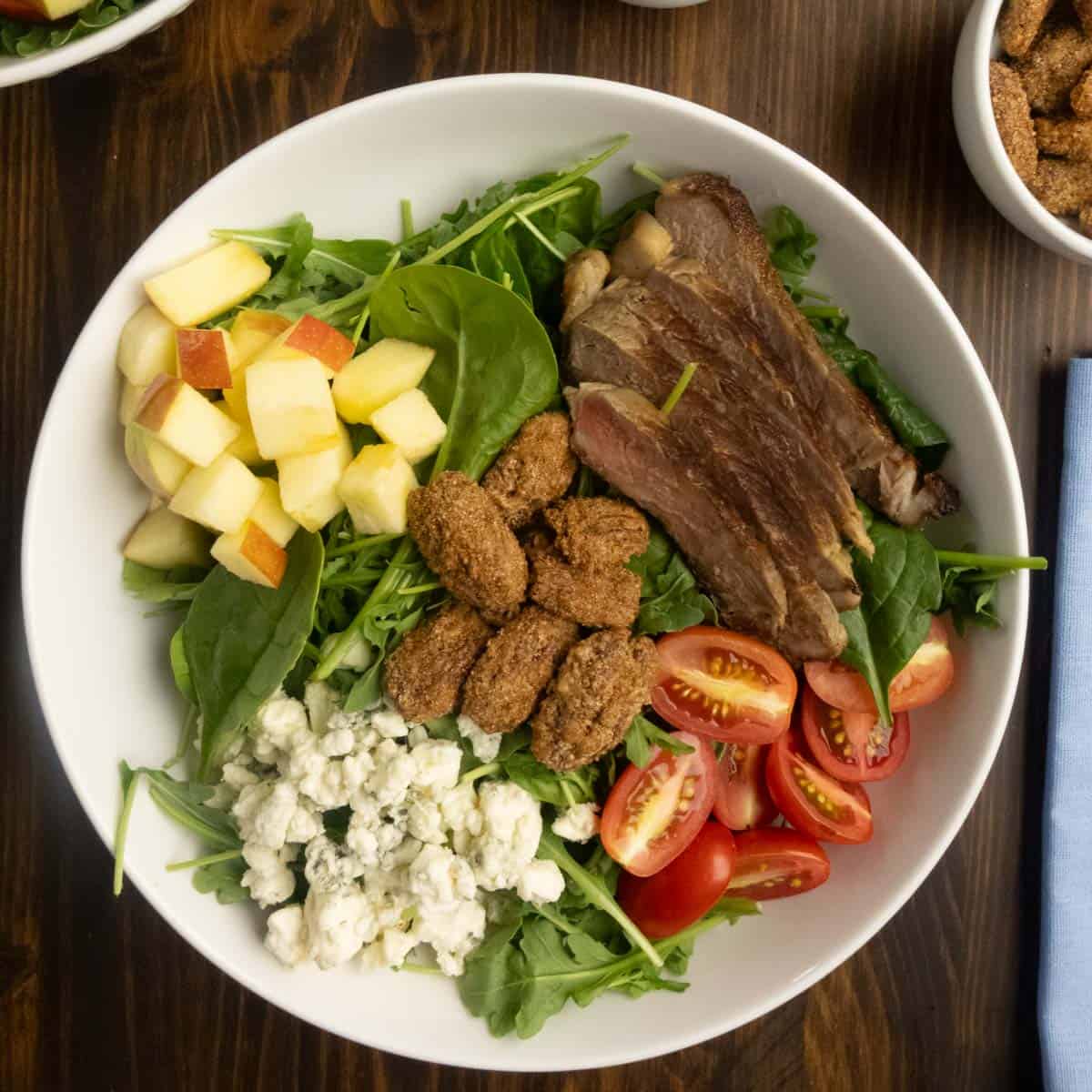
Cozy beef stew is a fall and winter staple in my house. Let me know if it makes it into your meal rotation.